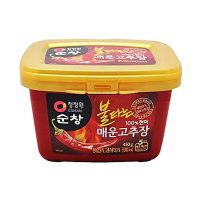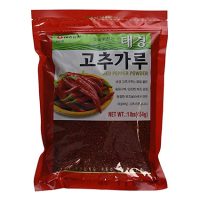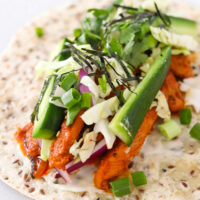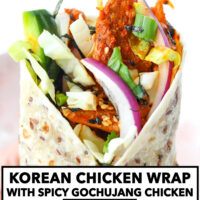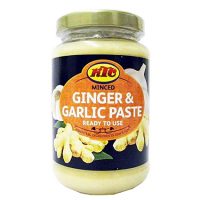 Buy Now →
Buy Now → Korean Chicken Wrap
Spicy gochujang chicken strips are piled onto tortillas and complimented with mayo, shredded cabbage, red onion, cucumber, coriander, spring onion, shredded seaweed and toasted sesame seeds in this easy meal prep friendly Korean Chicken Wrap!
- Prep Time: 20
- Cook Time: 8
- Total Time: 28 minutes
- Yield: 5 1x
- Category: Lunch
- Method: Sauté
- Cuisine: Korean-inspired
Ingredients
Scale
For the Spicy Gochujang Chicken:
- 3 TBLS Gochujang (Korean chili pepper paste – note 1)
- ½ TBLS Gochugaru (course ground Korean chili powder flakes – note 1), to taste
- 2 TBLS Ginger Garlic Paste (note 2)
- 2 TBLS Low Sodium Light Soy Sauce
- 1 TBLS Mirin (Japanese sweet rice wine – note 3)
- ½ TBLS Korean Sake (optional – note 4)
- 1 TBLS Honey
- ¾ TSP Kosher Salt (note 5)
- ½ – 1 TSP freshly cracked Black Pepper, to taste
- ½ – 1 TSP ground Cayenne (optional), to taste
- 1 TBLS Sesame Oil
- 1 TSP Pure Chili Oil (optional – without seeds/flakes)
- 400 grams / 14 ounces Chicken Breasts, boneless, skinless – cleaned and pat-dried, sliced into ½-inch wide strips
- 1.5 TBLS Canola Oil (or other neutral flavored cooking oil), for cooking
- ¾ small Red Onion – thinly sliced
For the Wraps:
- 4 – 5 Tortillas (plain, herbs, four seeds, whole wheat, etc. – your choice)
- 3 – 4 TBLS Mayonnaise, as needed
- ¾ cup shredded Cabbage (regular green or red cabbage)
- ¼ small Red Onion – thinly sliced
- 1 small Cucumber – sliced into 1.5-inch long and ½-inch wide strips
- 2–3 TBLS Coriander (Cilantro) – finely chopped
- 1 Spring Onion (Scallion/Green Onion) – finely chopped
- 2 – 3TBLS finely shredded Roasted Seaweed (kizami nori – optional – note 6)
- 1 TBLS Toasted White Sesame Seeds
- 1 TBLS Toasted Black Sesame Seeds
Instructions
- Marinate the spicy gochujang chicken: In a medium-sized mixing bowl, combine the gochujang, gochugaru, ginger garlic paste, low sodium light soy sauce, mirin, Korean sake, honey, kosher salt, black pepper, ground cayenne, sesame oil, and pure chili oil. Mix with a spoon until smooth and combined well. Clean and pat-dry the chicken breasts and slice into ½-inch wide strips. Transfer to the marinade bowl and mix well to coat. Cover with cling wrap and place in the fridge to marinate for 2-4 hours, or overnight for best flavor.
- Cook the chicken: Take out the bowl with the marinated chicken from the fridge 30 minutes before you plan to cook to take the chill off. Heat canola oil in a medium-sized skillet over medium-high heat. Once hot, add the chicken and all of the marinade in the bowl to the skillet. Sauté for 5 minutes, then add the sliced red onion and sauté for another 2-3 minutes until softened and the chicken has cooked through. (You can check for doneness by cutting a piece to make sure it’s white inside). Remove the pan from the heat.
- Assemble wraps: Warm the tortillas as per package instructions in the microwave. Spread mayonnaise on each tortilla. In the center and upper two thirds of the tortillas, add some of the spicy gochujang chicken and top with shredded cabbage, sliced red onion, and cucumber. Sprinkle with chopped coriander, spring onion, shredded seaweed, and toasted white and black sesame seeds. Fold the wrap over the bottom. Then fold in the left side of the wrap, followed by the right side to seal. Poke a toothpick through the center to hold the wrap and filling in place. Fold and seal the remaining wraps. Then serve and enjoy!
Notes
- Gochujang and gochugaru. Gochujang is a Korean chili paste made with fermented soybeans, glutinous rice, red chili pepper flakes, and salt. Gochugaru is a Korean coarse ground chili powder. Spice levels for both vary depending on the brand. Gochujang can be found in the Asian aisle of most mainstream supermarkets today and in Asian or Korean supermarkets. Gochugaru is available in Asian or Korean supermarkets and online.
- Ginger Garlic Paste. This in a paste that’s commonly used in Indian cooking instead of fresh garlic and ginger. It has an ultra-smooth and fine texture and is great for marinades. Find it in an Indian grocery store or purchase a jar online. Alternatively, use 1 tablespoon each of smashed or finely minced fresh ginger and garlic instead.
- Mirin. This is a Japanese sweet rice wine that is often used as a sweetener in Japanese cuisine. Korean cuisine has a counterpart, mirim, which is identical in flavor and taste. Look for it in an Asian supermarket. If you prefer not to cook with alcohol, substitute with more honey instead.
- Korean Sake. This is a Korean cooking wine used to help tenderize and bring out the flavors in the meat. You can use Japanese sake instead too. Omit if you prefer not to cook with alcohol.
- Kosher Salt: Use slightly less than half the amount indicated if using iodized sea salt.
- Finely shredded Seaweed (nori): You can find store-bought roasted shredded seaweed in packs in packs at Japanese and Asian supermarkets. It has a savory umami flavor and crisp texture, and commonly used to top rice, noodles, vegetables, and meat and seafood bowls in Japanese and Korean cuisine. Feel free to leave it out if you don’t have it on hand.
- Adjust spice level to taste. To make the chicken milder, use less gochujang (2 tablespoons instead of 3). You can also use less (or omit) of the gochugaru, ground cayenne, and pure chili oil in the chicken marinade.
- Leftovers and storage. Leftover spicy gochujang chicken can be stored in the fridge in a sealed airtight container for 3-4 days. You can either warm the chicken for a few seconds in the microwave before assembling the wraps, or use it cold. It tastes great either way!
- Recipe total time does not account for marinating the spicy gochujang chicken.
- See ‘Variations’ section to customize these wraps.
Nutrition
- Serving Size: 1 wrap
- Calories: 468
- Sugar: 14.1g
- Sodium: 1394.4mg
- Fat: 22g
- Saturated Fat: 3.2g
- Unsaturated Fat: 17.3g
- Trans Fat: 0g
- Carbohydrates: 43.6g
- Fiber: 2.9g
- Protein: 24.4g
- Cholesterol: 61.9mg
Find it online: https://thatspicychick.com/korean-chicken-wrap/

